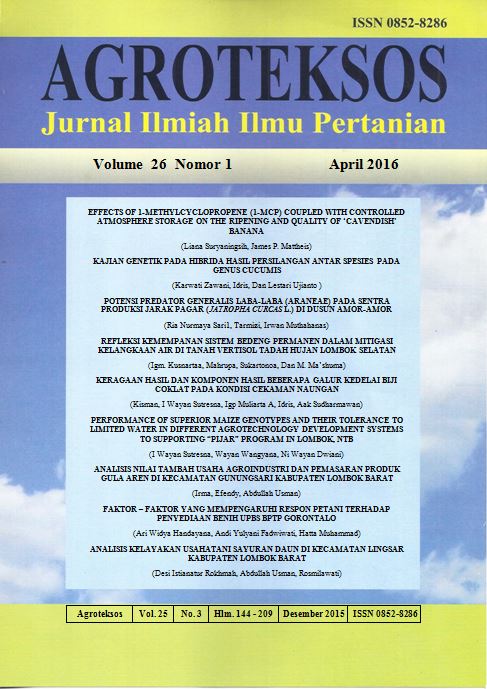POTENSI PREDATOR GENERALIS LABA-LABA (ARANEAE) PADA SENTRA PRODUKSI JARAK PAGAR (JATROPHA CURCAS L.) DI DUSUN AMOR-AMOR
Main Article Content
Abstract
Jarak pagar merupakan salah satu tanaman yang bisa dijadikan sebagai sumber energi alternatif, tetapi produksi biji jarak pagar masih rendah karena adanya kendala gangguan oganisme pengganggu tanaman (OPT). Penggunaan pestisida untuk mengendalikan hama tersebut kurang efektif sehingga dicari alternatif, yaitu dengan menggunakan musuh alami. Laba-laba merupakan salah satu musuh alami yang ditemukan di pertanaman jarak pagar. Tujuan penelitian ini untuk mengetahui potensi (Keanekaragaman, Kelimpahan, dan Dinamika Populasi) laba-laba sebagai predator generalis pada pertanaman jarak pagar. Penelitian dilakukan di Dusun Amor-Amor, Desa Gumantar, Lombok Utara dari bulan September sampai Desember 2013. Metode yang digunakan dalam penelitian yaitu metode deskriptif. Pengamatan dilakukan dengan pemasangan perangkap yellow pan trap dan pit fall trap masing-masing 12 dan 20 buah diletakkan secara acak di blok sampling secara diagonal. Konsep Shannon-Wiener dan Rumus michael 1995 digunakan untuk menghitung besarnya nilai indeks keragaman dan kelimpahan laba-laba, sedangkan gambaran dinamika populasi dibuat berdasarkan jumlah laba-laba yang ditemukan setiap pengamatan. Hasil penelitian ditemukan 19 spesies dari 6 famili laba-laba dengan indeks keragaman termasuk dalam katagori keragaman sedang (H’ 2,49). Oxyopes matiensis mendominasi dari spesies lainnya dengan nilai kelimpahan 25,25 % diikuti oleh Pardosa sumatrana (14,43%), sementara spesies lain kelimpahannya hampir seragam berkisar antara 0,66-5,25% . Dinamika populasi masing-masing famili laba-laba berfluktuasi selama pertumbuhan tanaman jarak pagar.
ABSTRACT
POTENCY OF SPIDERS (ARANEAE) AS GENERALIST PREDATOR IN CASTOR PLANT (Jatropha curcas L.) PRODUCTION CENTER IN AMOR-AMOR
Castor is one of the plants that can be used as alternative energy resource. However, the yield of castor seed is still low caused of the pests. The use of pesticides is less effective to control pests so that alternative method to control pests needed such as using natural enemies. Spider is one of the natural enemies found in castor plantation. The aim of this research is to observe the potencies (diversity, abundance, and population dynamics) of the spiders as generalist predators in castor plantation. This research was conducted in Amor-amor, Gumantar Village, North Lombok Regency from September to December 2013. The method used in this research was descriptive method using 12 yellow pan traps and 20 pit fall traps. The traps were put randomly on the sampling block diagonally. Shannon-Wiener Concept and the formula to calculate variety index and abundance of spiders made by Michael (1995) were used, whereas the diversity index of population was made based on the number of spiders found in each observation. The results are 19 species of 6 families of spiders found with diversity index (H’) 2.49, which means that the diversity of spiders in the castor plantation was moderate. The abundance value of Oxyopes matiensis dominated other species with abundance value 25.25% followed by Pardosa sumatrana (14.43%) while the abundance of other species was about 0.66-5.25%. population dynamic of each family of spiders fluctuated during the growth of castor plant.

